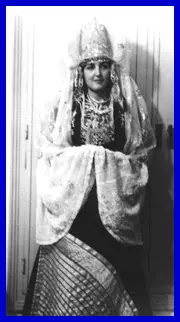
Morocco
North,
South, East and West
November
12, 2000
Makor,
35 W. 67th St.
Manhattan
with
Gil
Anidjar
Alegría
Bendelac
and
Habiba
Boumlik

Morocco
North,
South, East and West
November
12, 2000
Makor,
35 W. 67th St.
Manhattan
with
Gil
Anidjar
Alegría
Bendelac
and
Habiba
Boumlik
Panel, public dialogue, complementary mint tea, courtesy of the T Salon & T Emporium.
General seating, $12. Co-sponsored by The Caliban Foundation and Lilian Dammond; coproduced by Joyce Allegra Maio and Makor. Special thanks to the Jewish Museum.
In cooperation with Makor and the Jewish Museum, Ivri-NASAWI presents "Morocco North, South, East and West," on Sunday, Nov. 12, 4 pm at Makor. This panel and vigorous public conversation with scholars Gil Anidjar, Alegria Bendelac and Habiba Boumlik will offer diverse perspectives on Moroccan Jewish experience and is designed to fully engage the audience.A Language of Our Own: Los Nuestros by Alegria Bendelac brings into play the unique culture of northern Spanish Moroccan Jewry and the language of Jaquetia. Dr. Bendelac, who has a Ph.D. from Columbia University and was the recipient of the French Government Palmes Academiques, retired from Pennsylvania State University as a Full Professor Emerita. She grew up in Tangier, Morocco in a family from Tetuan whose ancestors were traced back to the Grand Rabbi of Seville. The culture and tradition of Haketia-speaking Sephardic Jews have rarely been in the limelight of research, and, as a minority within a minority within a minority, remained pretty much ignored by historians, linguists and ethnologists.
Exploring questions of place, culture and identity, Judeo-Maghrebian Spaces in Literature by Gil Anidjar offers a perceptive and imaginative discussion of North African Jewish literature. Anidjar addresses the Francophone Mektoub by Moroccan writer Gilles Zenou (1987) and the Hebrew ''Aqudby Albert Swissa (1990) in order to raise the question of the political dimension of Judeo-Maghrebian writing in both Hebrew and French, and its relation to Zionism and post-Zionism. Anidjar is Assistant Professor in the Department of Middle East and Asian Languages and Cultures at Columbia University.
South by Southwest: Berbers & Jews by Habiba Boumlik, discusses the lives and inter-cultural experiences of Jews and Berbers in the south of Morocco where the two communities have a fascinating, often intertwined history. Dr. Boumlik earned her Ph.D in cultural and social anthropology from Strasbourg, France. She was born in Tafraout, a small Berber village in Southwest Morocco, an area where more than 20% of Moroccoís Jewish population used to live, and seven kilometers from the last mellah or Jewish quarter in her region before its population left for Israel in 1957. Although she is from a Muslim background, she was always intrigued by the name and reputation of her native village (Aday), which was referred to as being a former Jewish locality. Boumlikís studies and work reflect her interest in Judaism, Berber issues and Judeo-Muslim relationships.
For more information about the Nov. 12 event at Makor, contact Joyce Maio, (212) 362-9074 or Makor, (212) 601-1000.
Ivri-NASAWI is an organization focusing on Sephardi/Mizrahi arts and culture, and was founded in 1996 by writers Ammiel Alcalay, Ruth Behar, Jordan Elgrably, Victor Perera, and Ella Shohat.
This panel has been curated by Ivri-NASAWI in conjunction with the new exhibit organized by the Jewish Museum of New York and Dr. Vivian Mann: Morocco: Jews and Art in a Muslim Land, Jewish Museum, 5th Ave. at 92nd St. The exhibit, which runs through Feb. 11, 2001, focuses on Morocco's multicultural art and traditions and the history of Jewish life in Morocco for over 2,000 years. 212-423-3200. www.thejewishmuseum.orgread Habiba Boumlik and Dalia Kandiyoti's review of the JewMu exhibit
read Holland Cotter's review from the New York Times
read a few reactions and comments